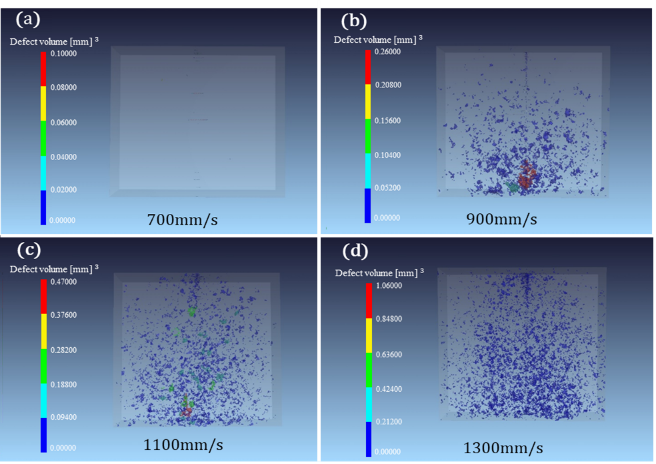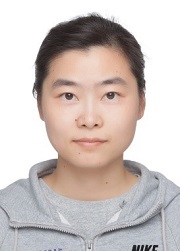PAPER ● OPEN ACCESS
1. Introduction
It is desirable to fabricate materials with adjustable physical properties that can be used in different industrial applications. Since the property of a material is highly dependent on its inner structure, the understanding of structure-property correlation is critical to the design of engineering materials. Recently, the paper "Modulation of Thermal Transport of Micro-Structured Materials from 3D Printing" was published in IJEM by Qiangsheng Sun et al. from Professor Yanan Yue's research group at Wuhan University. In this article, based on the relationship between material structure and physical properties, a strategy to control the thermophysical properties of materials by controlling the speed of 3D printing to generate different microdefects was proposed. Samples were prepared at four different scanning speeds and pore characterization was studied. It was found that there was an approximate linear relationship between porosity (defect degree) and scanning speed. By measuring the thermal conductivity, the relationship between thermal conductivity and scanning speed was obtained, and the thermal conductivity of the new sample can be predicted from its printing speed according to the correlation. Confirmatory experiments show that the error between the measured and predicted thermal conductivity of the new sample is only 0.6%, which proves the accuracy of the prediction method. The results of this study provide theoretical and experimental basis for 3D printing technology to regulate the thermophysical properties of materials.
Key words: Modulation, Thermal Property, Microstructure, 3D Printing, Speed
Highlights
● Proposed a strategy to control the thermal properties of materials by controlling the scanning speed of 3D printing to generate internal microdefects.
● Based on the principle of infrared imaging, the thermophysical property measurement method is established and applied to the real-time measurement of 3D printed samples.
● The physical model of 3D printed materials was established to simulate the heat transfer process , and the effects of temperature and porosity on material properties were explored.
2. Background
The thermophysical properties of the material can be adjusted by adding high thermal conductivity filler or changing the microstructure of the material. Additive manufacturing, commonly known as three-dimensional (3D) printing, has strong capabilities for manufacturing complex architectures and virtual 3D objects. In the printing process, laser power, scan speed, scan spacing and layer thickness are critical to the structure of the material. By controlling these parameters and introducing microstructures such as pores, microstructures and chemical additives, the physical properties of the printed material and structure can be adjusted. The anisotropic materials and functionally graded materials (FGMs) can be obtained by designing complex microstructures and specific pore distributions.
3. Recent Advances
Firstly, the microscopic characteristics of 3D printed samples are studied. When the scanning speed is low, a few pores are observed in the SEM image at low magnification in figure 1(a). At the same time, its density is higher than others. At a high magnification (inset in figure 1(a)), some pores appear and show a perfectly round shape with a diameter of 5-10 μm. With the increase of scanning speed, the porosity obviously increases, the shape of the pores gradually become larger and irregular. Figures 1(b)-1(d) clearly shows that the pores contain unfused powder particles. The results of micro CT show that there is an almost linear increase relationship between porosity and total number of pores and scanning speed, therefore it can be predicted that thermophysical properties of materials can be controlled by controlling scanning speed.

Figure 1. SEM images of the 3D-printed steel samples’ surface formed by different scanning speeds of (a) 700 mm/s, (b) 900 mm/s, (c) 1100 mm/s, (d) 1300 mm/s. (The inset shows the detail of the pore under the higher magnification.)

Figure 2. Micro CT image of the 3D-printed iron materials formed by different scanning speeds of (a) 700 mm/s, (b) 900 mm/s, (c) 1100 mm/s, (d) 1300 mm/s.
In order to effectively measure the thermal properties of 3D printed samples, the research group built a non-destructive measurement platform based on infrared imaging thermal properties. This method can realize single-side real-time measurement of samples, and the measurement is simple and quick, with low environmental requirements, which can be effectively applied to various industrial sites. The measured results of the thermal conductivity of the sample are shown in figure 3. By fitting the relationship between the thermal conductivity k and the scanning speed v, the expression can be obtained:
![]()
Under the same experimental conditions, the new sample was printed with a new scanning speed and the thermal physical properties were predicted and measured. The difference between the predicted value and the experimental results was only 0.6%, which showed the reliability of the above relationship.

Figure 3 (a) Characterization results of scanning speed dependent porosity and total number of pores. (b) results of scanning speeds dependent thermal conductivity
To deeply explore the heat transfer mechanism inside the porous stainless-steel samples, a steady-state model was established and numerical simulation was carried out. The simulation results are in agreement with experimental results. The heat transfer mechanism of pores is the key to affect porous media materials. In this paper, a single-pore structure model was also established to study heat transfer characteristics in a single pore, including heat transfer by convection, radiation and heat conduction in the pore, as shown in figure 4. In addition, it is found that the effect of temperature on the physical properties of 3D printing materials is as follows: The thermal conductivity decreases with the increase of temperature, and the thermal conductivity of the sample with high porosity decreases faster with the increase of temperature.

Figure 4. Thermal simulation of single pore configuration. (a) Temperature field and isotherm. (b) Radiation field. (c) Velocity field and flow direction. (d) Streamline.
4.Perspectives
3D printing technology can be effectively used to adjust the thermophysical properties of materials, playing an increasingly important role in the field of functional materials and directional manufacturing. In the future, thermal property design of materials can be carried out according to the actual demand to achieve directional manufacturing of materials. In addition, in order to achieve higher accuracy and smaller size thermo-physical properties of materials, further research on microscale microstructure and micro/nano scale heat and mass transfer is needed.
5. About the Authors
The first author of this paper is Qiansheng Sun, and the corresponding author is Associate Professor Shen Xu, School of Mechanical and Automotive Engineering, Shanghai University of Engineering Science, and Associate Professor Jun Zhang and Professor Yanan Yue, School of Power and Mechanical Engineering, Wuhan University. Collaborators include Associate Professor Jianmei Wang and master students Zhixiang Xue, Yang Chen and Ruding Xia from the School of Power and Mechanics, Wuhan University.
This work was supported by the National Key R&D Program of China (Nos. 2018YFB1106100, 2019YFE0119900), the National Natural Science Foundation of China (No. 52076156), and the Fundamental Research Funds for the Central Universities (No. 2042020kf0194).

Qiangsheng Sun, master candidate of School of Power and Mechanical Engineering, Wuhan University, supervised by Professor Yanan Yue. He graduated from school of Power and Mechanics, Wuhan University with a bachelor degree, and His research direction is micro-nano scale thermal properties and thermal measurement technology.

Shen Xu is an Associate Professor at Shanghai University of Engineering Science. She received his bachelor's degree from East China University of Science and Technology, master's degree from Fudan University, and doctor's degree from Iowa State University. Prof. Xu’s research interests include theoretical and experimental research on energy transfer in micron/nanometer scale, heat transfer behavior of new materials and complex nanostructures, and coupling of photothermal multi-physical fields. She has presided over one program for Young Oriental Scholars in Shanghai Colleges and universities, one program for Young Scholars of National Natural Science Foundation of China, and one program for general program of National Natural Science Foundation of China. Prof. Xu has published 40 SCI papers in Nano Energy, International Journal of Heat and Mass Transfer, Optical Express and other high-level journals with more than 300 citations. She has published a monograph, one invention patent, and is a reviewer of several international journals.

Jun Zhang, Associate Professor, School of Power and Mechanical Engineering, Wuhan University, member of NDT Standardization Technical Committee and New Technology Special Committee of NDT Branch of Chinese Mechanical Engineering Society. For a long time, he has been engaged in the research of laser ultrasonic technology and intelligent equipment, special piezoelectric materials, stress monitoring and non-destructive testing technology.Prof. Zhang has a solid theoretical basis and practical experience in ultrasonic non-destructive testing. He has published more than 30 high-level SCI papers, obtained more than 10 national invention patents, and developed more than 5 sets of industrial testing equipment for nuclear power systems.Prof. Zhang presided over a number of national projects and transverse cooperation projects, including national key r&d projects: "made of metal material of high frequency ultrasonic testing technology and equipment", major scientific instruments and equipment development projects: "the underwater ultrasonic, electromagnetic, radiation comprehensive development and application of nondestructive testing system ", defense department bureau foundation research project corpus: "Research on simulation Technology of Laser Ultrasonic Detection" and Topic of Aerospace Innovation Fund: "Research on Laser Ultrasonic CT Imaging technology of aerospace light alloy". In 2016, the project "Industrial Intelligent Ultrasonic Testing Theory and Application key Technology" won the first prize of Jiangsu Provincial Science and Technology Progress Award, and the second prize of National Science and Technology Progress Award in 2017.

Yanan Yue, Professor and Director of Power Engineering Department, School of Power and Mechanical Engineering, Wuhan University. He is mainly engaged in the research of thermal properties and thermal measurement technology of micro/nano materials. Prof. Yue has presided over 4 national Natural Science Foundation projects, 1 National Key R&D Program of China and many other Provincial and ministerial fund projects and enterprise R & D projects. He has published more than 60 SCI papers, including 3 cover articles and 1 ESI highly cited article, with more than 1600 citations. More than 10 invention patents have been applied for and authorized to be accepted. Prof. Yue is also a member of the Youth Working Committee of Heat and Mass Transfer Branch of Chinese Society of Engineering Thermophysics, a liaison of Wuhan University of Chinese Society of Power Engineering, and a member of the Teaching Committee of Energy and Power Engineering subject of China Electric Power Education Association. In addition, he has been guest editor of Journal of Physics D, Applied Physics Journal, Advisory Panel Member, Nanotechnology, and reviewer of more than 40 internationally renowned journals, and has won the first prize of Hubei Province teaching Achievement and the second prize of China Electric Power Science and Technology Progress.










